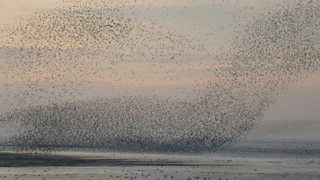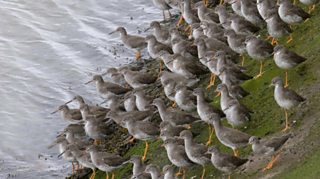Communal roosting amongst birds comes into its own during the winter months. Most people are aware of the spectacular pre-roost gatherings of starlings and the wonderful displays they put on as they gather at a favoured site. What is probably less well known is that several other species also roost communally in large numbers and put on just as impressive pre-roost shows.
Roosts of can number in the tens of thousands; as they wheel in the sky, they form ‘smoke clouds’ of birds in the same way that Starlings do. hardly ever roost alone though and are often joined by hundreds, if not thousands, of jackdaws, leading to a much more evocative experience for the observer. As individuals of both species in the flock call constantly to each other before falling silent in the roost, the resultant cacophony is amazing to hear.

Knot by Dawn Balmer
Both of these species start to gather during the late afternoon before dropping into the roost site as dusk falls. For coastal waders, however, the timing for going to roost is governed by the timing of the high-tide. As the tide rises and the mud covers, flocks of waders can be seen wheeling around the sky, looking dark one minute as they show their upperparts in unison and white the next as the underparts come into view. The numbers involved can be truly awesome, with as many as 100,000 birds involved. These large flocks will largely be made up of , and but may also contain smaller numbers of other species too, including , and .

Redshank by John Harding
You don’t have to travel to a far-flung corner of the country to experience roosting behaviour. Many of our villages, towns and cities will hold smaller roosts of Starlings and Rooks and, to experience the magic of a communal roost of s, you often only need to visit your local supermarket or hospital. These buildings seem to provide just what a cold wagtail needs – some wasted heat, shelter from the wind and artificial light that makes it difficult for hunting Tawny Owls. Our gardens also provide safe roosting sites for birds. The nest box that was used during the spring and summer to raise a brood of youngsters might now provide a snug bed for the night for a single blue and great tit. These tits really do seem to prefer their own company during long winter nights but for it is definitely a case of the more the merrier. The record number of Wrens found roosting in a single nest box stands at 62. If you turned your nest box camera off at the end of the summer it is worth switching it on again. You never know who might be using it as a winter residence.

Gulls by Mike Weston
It is also worth casting an eye skywards from mid-afternoon onwards. At this time gulls start to head towards a reservoir or gravel pit to spend the night, sitting in safety on the open water. Even the most land-locked of counties hold some impressive gull roosts that will contain thousands of , , and , the composition of the flocks will vary in different parts of the country though.
